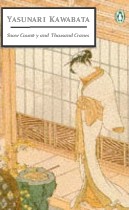 Yasunari Kawabata •
Yasunari Kawabata •
Snow Country •
Kawabata writes with the spareness of poetry and the wistful quality of music heard over water, weaving a dreamlike winter tale out of silkworms, geisha, and hot springs.
Snow Country’s most enduring image comes early in the book. Shimamura is traveling by rail to a remote village on Japan’s main island. Looking out the window of his train compartment, he sees the floating reflection of a woman’s face.
And just like that, the spell is cast. He has to know everything about her: who she is, where she’s going, what her conversation with the stationmaster means. And so do you.
Shimamura is an avid student of the Western ballet—yet has never witnessed a performance. “He preferred not to savor the ballet in the flesh . . . It was like being in love with someone he had never seen.” In much the same way, he is a spectator in his own life, observing it all secondhand. Even his involvement with the passionate teenage Komako doesn’t seem to thaw him.
The massive snowfalls in this part of Japan—up to 15 feet—create an eerie, frozen landscape that adds to the sense of isolation and remove. Sounds are muffled; a voice is “calling out as if to someone who could not hear, on a ship far away.” People must tunnel their way from one building to another. “They say that in the next town up the line the schoolchildren jump naked from the second floor of the dormitory. They sink out of sight in the snow, and they move around under it as though they were swimming.”
Snow Country was one of the three works cited when Kawabata was awarded the Nobel Prize for Literature in 1968.







Your email address will not be published.